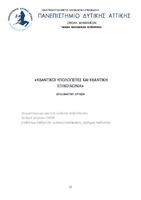| dc.contributor.advisor | Kandarakis, Ioannis | |
| dc.contributor.author | Ανδριόπουλος, Ανδρέας | |
| dc.date.accessioned | 2021-11-03T08:49:22Z | |
| dc.date.available | 2021-11-03T08:49:22Z | |
| dc.date.issued | 2021-07-14 | |
| dc.identifier.uri | https://polynoe.lib.uniwa.gr/xmlui/handle/11400/1477 | |
| dc.identifier.uri | http://dx.doi.org/10.26265/polynoe-1328 | |
| dc.description.abstract | Η παρoύσα εργασία αποτελεί μια μελέτη επί των διαφόρων τεχνολογιών στην
Κβαντική Επικοινωνία. Ειδικότερα, αναλύονται τα πλεονεκτήματα που διαθέτει η
χρήση κβαντικών τεχνολογιών έναντι των κλασικών τηλεπικοινωνιών, ενώ γίνεται
αναφορά και στο πώς θα μπορούσαμε να υλοποιήσουμε τέτοιες τεχνικές.
Η δομή της εργασίας είναι η εξής: στο 1ο κεφάλαιο γίνεται μια αναγκαία
επισκόπηση των βασικών εννοιών της Κβαντομηχανικής. Ύστερα, στο 2ο κεφάλαιο
αναπτύσσονται τα βασικά της κβαντικής υπολογιστικής (qubits, κβαντικές πύλες
κτλ.) και αφού παρατεθούν οι βασικές αυτές έννοιες, δίνουμε μια περιγραφή των
στοιχειωδών περί Κβαντικής Κρυπτογραφίας και Κβαντικής Διανομής Κλειδιού. Στο
3ο κεφάλαιο παραθέτουμε κάποιες πρώτες απόπειρες υλοποίησης συστημάτων
κβαντικών υπολογιστών, ειδικότερα γίνεται λόγος για ιοντικούς κλωβούς (ion traps)
και για την εφαρμογή NMR τεχνολογιών στην κβαντική υπολογιστική. Τέλος, το 4ο
κεφάλαιο αποτελεί μια επισκόπηση των πιο σύγχρονων τεχνολογιών στην Κβαντική
Επικοινωνία. Συγκεκριμένα, αναφερόμαστε (i) σε ποικίλες εφαρμογές της κβαντικής
οπτικής στις επικοινωνίες, (ii) στην δυνατότητα ανάπτυξης κβαντικού διαδικτύου,
(iii) στο πρόγραμμα της CubeSat για την αξιοποίηση κβαντικών τεχνολογιών σε
δορυφορικά συστήματα και (iv) την δυνατότητα εκτέλεσης κβαντικής επικοινωνίας
σε κανάλια μηδενικής χωρητικότητας. | el |
| dc.format.extent | 64 | el |
| dc.language.iso | el | el |
| dc.publisher | Πανεπιστήμιο Δυτικής Αττικής | el |
| dc.rights | Αναφορά Δημιουργού - Μη Εμπορική Χρήση - Παρόμοια Διανομή 4.0 Διεθνές | * |
| dc.rights | Attribution-NonCommercial-NoDerivatives 4.0 Διεθνές | * |
| dc.rights | Attribution-NonCommercial-NoDerivatives 4.0 Διεθνές | * |
| dc.rights.uri | http://creativecommons.org/licenses/by-nc-nd/4.0/ | * |
| dc.subject | Cubesat | el |
| dc.subject | Qubits | el |
| dc.subject | Κβαντική επικοινωνία | el |
| dc.subject | Κβαντικοί υπολογιστές | el |
| dc.subject | Κβαντική διανομή κλειδιού | el |
| dc.title | Κβαντικοί Υπολογιστές Και Κβαντική Επικοινωνία | el |
| dc.title.alternative | Quantum Computers and Quantum Communication | el |
| dc.type | Διπλωματική εργασία | el |
| dc.contributor.committee | Φούντος, Γεώργιος | |
| dc.contributor.committee | Michail, Christos | |
| dc.contributor.faculty | Σχολή Μηχανικών | el |
| dc.contributor.department | Τμήμα Μηχανικών Βιοϊατρικής | el |
| dc.description.abstracttranslated | The present thesis comprises a study upon various technologies that stem from
quantum communication. In particular, we analyze the advantages of quantum
technologies over classical communication, while possible ways of applying said
technologies are also examined.
The structure of this thesis is as follows: in Chapter 1 we overview some
necessary theory of quantum mechanics. Then, in Chapter 2 we develop the
fundamentals of quantum computing (qubits, quantum gates etc.) and once these
fundamental terms have been develop, we give a description of the basics in
quantum cryptography and quantum key distribution. In Chapter 3 we list several
attempts that have been made for the implementation of quantum computing. In
particular, we discuss ion traps and NMR technology applications in quantum
computing. Finally, Chapter 4 comprises an overview of modern technologies in
quantum communications. More specifically, we refer to (i) various applications of
quantum optics in communications, (ii) the capability of developing quantum
internet, (iii) the CubeSat program for utilization of quantum technologies in satellite
systems and (iv)the capability of carrying out quantum communication through zero
capacity channels. | el |


